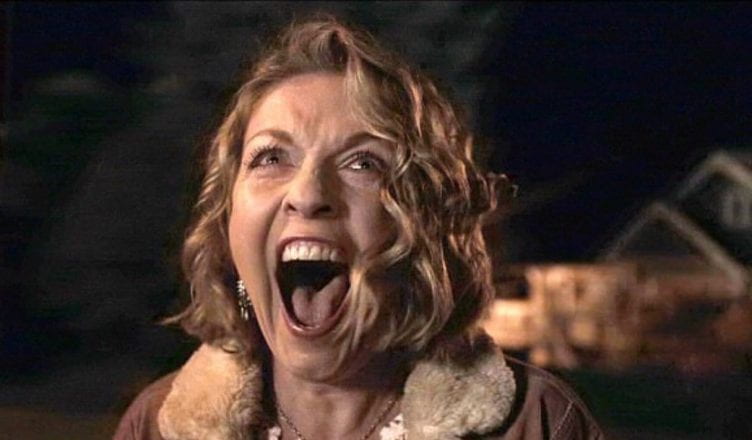Film Deets:
Director: David Lynch
Screenplay: Mark Frost & David Lynch
Actresses: Sheryl Lee, Grace Zabriskie
Category: Child Abuse
Themes: Abuse, Recovered Memory, Family Trauma
Why do these screams matter?
The de facto third season of Twin Peaks catches up with many of the series’ beloved characters, with sometimes devastating consequences. Such is the case with Laura’s (Sheryl Lee) mother, Sarah (Grace Zabriskie), whose grief and guilt over her daughter’s death appear to have devolved into self-harming coping mechanisms that leave her largely isolated and alone. The scene opens in an alternate timeline set in 1989. The camera lingers on the iconic Palmer House as Sarah’s screams echo from an empty room. As Sarah comes into frame, she screams as she attempts to break a framed photo of Laura with a bottle, to no avail.
While this scene has been read as Sarah being possessed by an evil spirit and as a fever dream by an already psychologically sensitive woman, I submit that the scene is designed to work in concert with the scream that will close out season 3. If we accept that Sarah’s screams in the original run of the series were a reflection of her guilt over having failed to stop Leland’s (Ray Wise) continuing rape of Laura, then Sarah’s smashing of the picture frame reads as a desperate attempt to rid herself of the guilt and torment that has all but consumed her. But the refusal of the picture frame to shatter indicates that there is nothing that she can do to escape her self-created prison. Rather, it’s the price she must pay for refusing to acknowledge the abuse that was taking place right in front of her.
As it does with Sarah, season 3 also gives the audience an older and darker version of Dale Cooper (Kyle MacLachlan). Having spent most of the season in a comatose state, Cooper’s first order of business upon being revived is to travel back to save Laura Palmer from her grisly end, which he seemingly accomplishes. But when Laura suddenly goes missing and Cooper’s exit from the Black Lodge results in him entering a new timeline in which Laura Palmer seemingly never existed, the show enters a territory the meaning of which is still being debated by fans. Because this is, after all, David Lynch’s storytelling, concrete answers aren’t especially prevalent. But here’s what we know. When Cooper enters this new timeline, he meets Carrie White (Sheryl Lee), a perfect doppelgänger of Laura Palmer. When he takes Carrie to Twin Peaks and arrives at Laura’s home, Carrie is confronted with Laura’s memories.
While this scene may be ambiguous in terms of the season’s overall story, there is no discounting how this moment punctuates for the audience the long-term impacts of childhood sexual abuse. When Cooper asks Carrie the year and she is unable to answer, the show is suggesting that time is irrelevant when it comes to navigating trauma. For survivors, the impacts of abuse are never erased. Sometimes, those impacts are front and center, and other times, they lurk beneath the surface- but the survivor is forever altered.
According to the American Psychological Association, clinical psychologists who study memory agree that although infrequent, “a memory of early childhood abuse that has been forgotten can be remembered later.” Further, research also indicates that Post-Traumatic Stress Disorder (PTSD) is not an uncommon impact of experiencing sexual abuse as a child. For the adult who has endured childhood sexual abuse, the impacts are often varied and can manifest themselves years after the initial abuse took place.
The scream here helps the audience understand that Carrie is the repressed version of Laura, likely stemming from her brain’s blocking of the abuse as a coping mechanism. She has no memory of the abuse she sustained and it is only once she returns to the site of the home in which her father violated her that her memories come flooding back. As she stares at the house and then at Cooper, Carrie hears the voice of Sarah, Laura’s mother, calling for Laura. And that’s when the memories come rushing back causing Carrie to scream. That the house goes dark in response to the scream indicates that it has lost its power in the wake of the anger and rage that Carrie’s scream encompasses; a public and vocal expression of abuse endured and a reclamation of personal agency that Laura never got the chance to have for herself. It’s a heartbreaking conclusion to the series, particularly since an earlier scene gives the impression that Cooper was able to rescue Laura. But Carrie/Laura’s scream here reminds the audience that, while you may learn to live with it, there is no erasing childhood sexual abuse. It’s a trauma that fundamentally changes a person forever.
Gokten, Emel Sari, and Caglar Uyulan. “Prediction of the Development of Depression and Post-Traumatic Stress Disorder in Sexually Abused Children Using a Random Forest Classifier.” Journal of Affective Disorders, vol. 279, Jan. 2021, pp. 256–265.
“Memories of Childhood Abuse.” American Psychological Association, 1995, https://www.apa.org/topics/trauma/memories.
“Part 1.” Twin Peaks: The Return, written by Mark Frost and David Lynch, directed by David Lynch, Lynch/Frost Productions, 2017.
“Part 18.” Twin Peaks: The Return, written by Mark Frost and David Lynch, directed by David Lynch, Lynch/Frost Productions, 2017.





